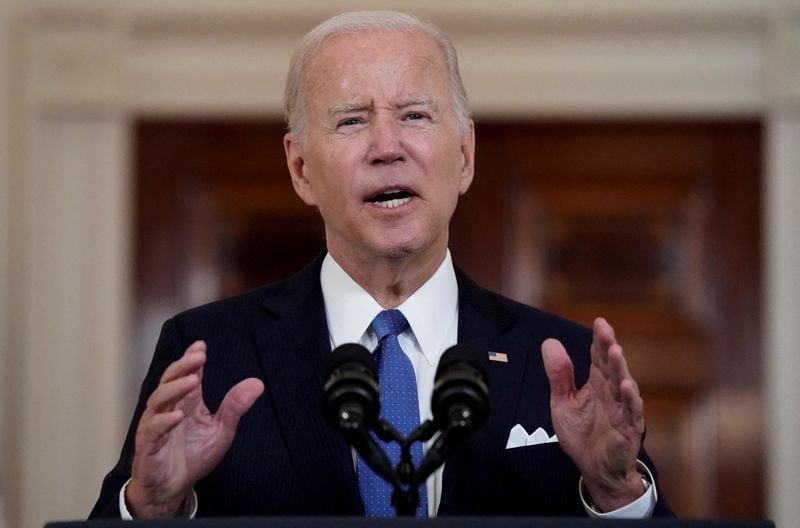By Max Hunder and Tom Balmforth
KYIV -Ukraine was set to pull its troops from the ruined city of Sievierodonetsk after weeks of street fighting and bombardment, the regional governor said, in what would be a significant gain for Russia as it grinds out its offensive in the east.
Russian troops also occupied a town about 10 km (6 miles) further south, both sides said on Friday, as Moscow closed in on the last slivers of Ukrainian-held territory in the industrial region of Luhansk.
Moscow said it had encircled about 2,000 Ukrainian and what it called foreign troops in the area. Reuters could not independently verify any of the battlefield accounts.
The reports came four months to the day since Russian President Vladimir Putin sent tens of thousands of troops over the border, unleashing a conflict that has killed thousands, uprooted millions and reduced whole cities to rubble.
If it goes ahead, the withdrawal from Sievierodonetsk would mark the biggest reversal for Ukraine since the loss of the southern port of Mariupol in May.
The latest Russian advances appeared to bring the Kremlin closer to taking full control of Luhansk, one of Moscow’s stated war objectives, and set the stage for Sievierodonetsk’s twin city of Lysychansk to become the next main focus of fighting.
Luhansk regional governor Serhiy Gaidai said troops in Sievierodonetsk had already received the order to move to new positions.
“Remaining in positions smashed to pieces over many months just for the sake of staying there does not make sense,” Gaidai said on Ukrainian television.
‘RED FLAG FLYING’
Russia invaded Ukraine on Feb. 24, but abandoned an early advance on the capital Kyiv in the face of fierce resistance bolstered by Western arms.
Since then Moscow and its proxies have focused on the south and Donbas, an eastern territory made up of Luhansk and its neighbour Donetsk, deploying overwhelming artillery in some of the heaviest ground fighting in Europe since World War Two.
Ukrainian forces had held out for weeks in Sievierodonetsk, trying to wear down Russian troops through attrition and buy time for the arrival of heavy weapons supplies.
“Our forces had to withdraw and conduct a tactical retreat because there was essentially nothing left there to defend. There was no city left there and, secondly, we could not allow them to be encircled,” Oleksander Musiyenko, a Kyiv-based military analyst, said.
Ukraine on Friday again pressed for more arms, with its top general, Valeriy Zaluzhniy, telling his U.S. counterpart in a phone call that Kyiv needed “fire parity” with Moscow to stabilise the situation in Luhansk.
Ukraine’s Defence Ministry said the Russians were trying to surround Lysychansk and mounting assaults on Sievierodonetsk to win full control. But spokesperson Oleksandr Motuzyanyk declined to comment on Gaidai’s remarks about a withdrawal.
Further south, Russian troops had entered the town of Hirske and fully occupied the surrounding district on Friday, municipal head Oleksiy Babchenko said.
“There is a red flag flying over the municipal administration (in Hirske),” a spokesperson for the regional administration told Reuters by telephone.
Russia’s defence ministry said it had taken Hirske and the nearby town of Zolote after what it described as a “rout” of Ukrainian soldiers. It earlier said it had encircled up to 2,000 Ukrainian troops, including 80 foreign fighters, at Hirske.
Vitaly Kiselev, an official in the Interior Ministry of the separatist Luhansk People’s Republic – recognised only by Russia – told Russia’s TASS news agency that there were about 4,500 Ukrainian servicemen in the area taken over by Russian and separatist forces in Hirske, but did not say what had happened to them.
Kiselev said it would take another week and a half to secure full control of Lysychansk and that an unknown number of people remained holed up and did not want to leave the Azot chemical plant in Sievierodonetsk.
The general staff of Ukraine’s armed forces said its troops had some success in the southern Kherson region, forcing the Russians back from defensive positions near the village of Olhine, the latest of several Ukrainian counter-assaults.
Ukrainian media showed footage of a school smouldering and gutted by Russian shelling in Avdiivka — a town in Donetsk region just inside Ukrainian-held territory. Reports said the school had been used as a first aid centre and the attack destroyed medicine and other supplies.
Reuters could not confirm the details of the fighting.
ARMS AND DEFENCE
Ukraine’s foreign minister played down the significance of the possible loss of more territory in the Donbas.
“Putin wanted to occupy the Donbas by May 9. We are (there) on June 24 and still fighting. Retreating from a few battles does not mean losing the war at all,” Dmytro Kuleba said in an interview with the Italian newspaper Corriere della Sera.
Russia says it sent troops into Ukraine to degrade its southern neighbour’s military capabilities and root out people it called dangerous nationalists.
Ukraine, which says Russia has launched an imperial-style land grab, this week won new support from the West.
European leaders approved Ukraine’s formal candidature to join the European Union – a decision that Russia said on Friday would have negative consequences and amounted to the EU’s “enslaving” neighbouring countries.
Ukrainian President Volodymyr Zelenskiy vowed in an interview with NBC News that he would fight for the release of two American veterans captured – according to Russian state media – by Russian-backed forces, saying he was honoured that the men had come to fight for Ukraine.
The war has had a massive impact on the global economy and European security arrangements, driving up gas, oil and food prices, pushing the EU to reduce its heavy reliance on Russian energy and prompting Finland and Sweden to seek NATO membership.
The U.N. nuclear watchdog said it was is increasingly concerned about the welfare of Ukrainian staff at the Russian-held Zaporizhzhia nuclear power plant in southeastern Ukraine, Europe’s largest.
The International Atomic Energy Agency has for months said that Zaporizhzhia, where Ukrainian staff are operating the plant under the order of Russian troops, poses a safety risk and that it wants to send a mission there.
(Reporting by Reuters bureaux; Writing by Michael Perry, Angus MacSwan, Andrew Heavens and Michael Martina; Editing by Himani Sarkar, William Maclean, Nick Macfie and Daniel Wallis)





















